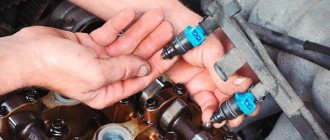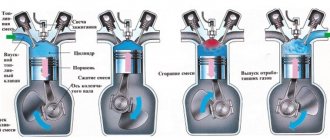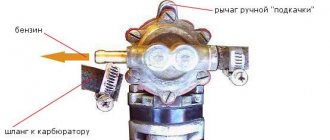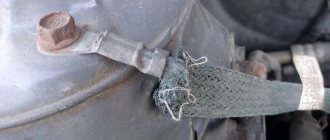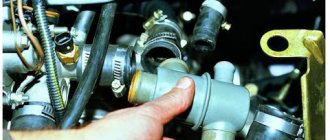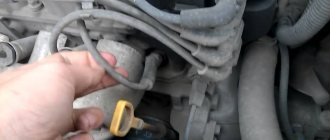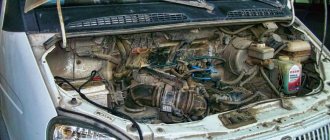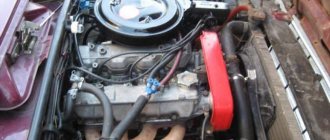If the car won't start
If the VAZ 2106 does not start, you must first identify the true reason. The probable causes of such a problem and possible ways to solve it are as follows.
- The car may not start due to faulty breaker contacts. To confirm or eliminate the risk of such a malfunction, it is necessary to check the condition of the contacts mentioned for the presence of gap violations or oxidation (burning) of the working surfaces. In the first case, you will need to adjust the gap, in the second, you will need to clean or replace the working surfaces. The compression spring will also need to be replaced if necessary.
- The problem may lie in the low voltage wiring of the VAZ 2106 car or in loosening (oxidation) of the wire terminals. You should check the wires going from the ignition coil to the distributor for breakdown and short circuit. There may also be problems with the ignition switch, which needs to be checked, and if it is faulty, it must be replaced or its contact group must be changed.
- There is a possibility of failure of the ignition coil, that is, the spark in the VAZ is lost. Perhaps the problem is a short circuit in the primary winding of this coil, which can be corrected by swapping high-voltage wires. If a spark on a VAZ 2106 appears in a place where it was not there before, but disappears on a new one, this indicates a fault in the spark plug wire.
- Problems with ignition distribution. The distributor capacitor may be broken; therefore, for normal operation of the car, it must be replaced. It also happens that the distributor is installed incorrectly, this leads to the car jerking during acceleration and then stalling.
VAZ 2106 stalls at idle
Post by Slalom » 26 Nov 2021, 13:58
Not so long ago I received a VAZ 21063 from my grandfather. Since then, my sleeves have been oiled and filled with gasoline, my hands are frostbitten, but I still drive the bus))) I have a problem starting the engine. Periodically, the engine idling suddenly begins to lose speed and eventually stalls and then does not start. At the same time, the car sits in the yard for a couple of days, after which I come back, try to start it and it starts as if nothing had happened. But then I drive a little and the same thing happens again. The starter turns, but the engine never even catches. There is a spark in all four spark plugs. I opened the carburetor cover and there was gasoline in the float chamber just above the jets - everything seemed to be fine. The jets that are accessible from above without removing the carburetor have been cleaned and there are no blockages in them. There is an injection from the spout into the first chamber, although as I understand it, it does not come into action during startup or at idle. I never understood this, I just started now. As far as I understand now, the fuel does not reach the cylinders or does not reach the required consistency.
Tell me how to diagnose the breakdown, what else can I look at? What could be the reason for the fact that after the car sits for a while it starts normally. Or maybe I should still remove the carburetor and clean it entirely?
I would also be grateful if you could tell me the contact of a good carburetor specialist. I will be even more grateful if such a specialist comes and teaches me how to deal with the problem on my real receiver for a fee.
| Rating: 6 112 |
| Reputation: +16 |
Thanked: 26 times Thanked: 25 times
VAZ 2106 does not start periodically
- Quote
Post by daskatzchen » 26 Nov 2021, 15:06
Messages: 14758 Registered: Dec 06, 2010, 00:00 From: Tyumen Center Experience: 1976 Car: really like it : Awards: 2
| Rating: 101 834 |
| Reputation: +197 |
Thanked: 1114 times Thanked: 1274 times
VAZ 2106 does not start periodically
- Quote
Post by Grigoryich » 26 Nov 2021, 16:55
We will never get what we want until we are grateful for what we have!
Osim haim!
Messages: 3053 Registered: Sep 12, 2007, 00:00 Car: peugeot 308 : Awards: 3
| Rating: 14 319 |
| Reputation: +45 |
Thanked: 90 times Thanked: 135 times
VAZ 2106 does not start periodically
- Quote
Post by uat » 26 Nov 2021, 17:08
Messages: 14758 Registered: Dec 06, 2010, 00:00 From: Tyumen Center Experience: 1976 Car: really like it : Awards: 2
| Rating: 101 834 |
| Reputation: +197 |
Thanked: 1114 times Thanked: 1274 times
VAZ 2106 does not start periodically
- Quote
Post by Grigoryich » 26 Nov 2021, 17:16
We will never get what we want until we are grateful for what we have!
Osim haim!
Messages: 3053 Registered: Sep 12, 2007, 00:00 Car: peugeot 308 : Awards: 3
| Rating: 14 319 |
| Reputation: +45 |
Thanked: 90 times Thanked: 135 times
VAZ 2106 does not start periodically
- Quote
Post by uat » 26 Nov 2021, 18:00
Why does the car stall while driving?
As for the most common malfunctions that many drivers of VAZ cars encounter, the list of common reasons includes those that lead to the fact that the domestic car 2106 stalls while driving. Let's look at them in detail.
- Low quality of fuel used. This is where experts recommend starting to look for the source of the problem. If, when draining the old fuel and replacing it with a new one, you are lucky and the car starts, you can confidently say that you should not skimp on the quality of gasoline for your car.
- Candles. Often, after changing the fuel and the problem persists, that is, the VAZ still does not start, suspicion falls on the spark plugs. You should check their condition after they are unscrewed and, if necessary, replace them with new ones.
- Fuel filter. Very often, a clogged filter can provoke interruptions in the fuel supply, as a result of which the VAZ 2106 stalls while driving. To eliminate the problem, it is enough to replace the fuel filter.
- Problems with the air filter are solved using the same method as with the fuel filter. A clogged filter does not allow air to pass through, which leads to engine pressure, that is, a drop in power. This way, the combustion process of the mixture will not take place, and as a result, the engine will stall.
- The problem is the fuel pump. A faulty fuel pump causes the VAZ 2106 to stall or not start at all. Treatment is checking the pump followed by repair or replacement.
- Battery: oxidation or poor terminal contact. The terminals should be checked, and then the battery should be cleaned or replaced.
- If the engine stalls while driving and won't start again, the cause may be the generator, which is not providing a charge. And since the car is powered only by the battery and, as you know, it doesn’t last long, the car starts working on the battery until it is completely empty.
- In modern brands, the cause of breakdown can be faulty electrical equipment. With such a problem, it is better to immediately contact specialists, because without experience and knowledge, you can replace half a car, but not get rid of the problem.
This concludes the review of the reasons leading to the VAZ 2106 not starting or stalling while driving. Spare no effort, time and financial resources for the well-being of your car, and it will respond with high-quality and long-term service.
As a rule, the true cause of the breakdown is revealed quite simply. And even a car owner who does not have deep knowledge of vehicle repair can easily correct problems that arise that are accompanied by incorrect behavior of his car.
Idling VAZ 2106
If your car starts to stall at idle, then the fuel filter needs to be properly adjusted or cleaned.
Table of contents
Adjustment Disappeared How to configure Malfunctions
Adjustment
To adjust the idle speed, the only tool you need is a flat, narrow screwdriver, preferably with a short handle. Adjusting the idle speed should only be done when the engine is warm. The timing and ignition clearances must be adjusted. If the adjustment is carried out on a cold engine, it will not bring the desired effect and it will not be possible to achieve stable performance.
Idle speed adjustment is carried out using 2 adjusting screws: 1st - the quality of the mixture and 2nd - its quantity (Fig. 2). By default, at the factory, adjusting screw 2 is equipped with a restrictive sleeve, which acts as a seal. Thus, the manufacturer indicates that the rotation of the screw is within the factory range. For complete adjustment and when it is not possible to adjust the idle speed, the restrictive sleeve is removed and the basic adjustment is carried out.
Use screw 1 to set the crankshaft speed to 900 min.-1. They can be checked on a special stand or using a tachometer located on the instrument panel.
Using screw 2, you need to achieve a CO2 value that falls within the range of values from 0.5 to 1.2%. A special device will help with this - a gasometer.
The rotation of screw 2 helps to change the crankshaft speed. In this case, we again adjust and set screw 1 to the value of the rotation speed within 900 min.-1.
The correct idle speed setting is checked by pressing the accelerator pedal and releasing it sharply. The crankshaft rotation speed should increase smoothly and without failure, and then decrease as well. The engine should not stall. If this happens or jerks are observed when you press the gas pedal, the setting must be repeated.
It is recommended to place the limiting bushings on the adjusting screws, focusing on the mounting lugs. After completing the idle adjustment, the engine should run stably.
gone missing
I had this happen too - I needed to thoroughly flush the bottom of the carburetor, check and, if necessary, replace the needle valve and adjust the position of the float. Particularly check the idle jet on the back of the carburetor opposite the valve cover.
Check the condition of the contacts, the integrity of the central high-voltage wire and the resistance of the slider. The ELXX valve on the Azon carburetor may be faulty, the tube may have broken or fallen off. A carburetor malfunction is also possible.
How to setup
To solve the problem of how to adjust the idle speed on a VAZ 2106, you need to stock up on a set of driver’s tools, although one screwdriver is enough for this technological operation. On the Internet you can watch the “VAZ 2106 idling” video clip about carrying out adjustment work to stabilize the idling speed of the vehicle.
To adjust the idle speed of the “six” carburetor, a number of preparatory conditions must be observed. These include:
The operation is carried out only on the motor that has reached operating temperature (about 90 degrees Celsius).
The clearances of the timing valves and ignition contacts (with a contact system) must correspond to the required dimensions.
When adjusting the idle speed of a VAZ 2106 carburetor on a cold engine, the required result cannot be achieved. If there is no idle speed, it will appear only if the correct adjustment conditions are met.
If the VAZ of the “sixth model” stalls at idle, then to find out how to adjust the idle speed, you need to use the following algorithm:
The process of adjusting the idle speed on a VAZ 2106 car is carried out using two screws for adjustment, the first is the quality screw, the second is the quantity of the mixture.
In accordance with the factory parameters, the quantitative adjusting screw is locked with a sealed limiter sleeve. To carry out adjustments and when there is no idle speed on the VAZ 2106, the seal is removed and adjustment work is carried out.
Using a high-quality screw, we achieve a value of 900 rpm, checking the value with the tachometer readings.
Using the quantity screw, we use a gas meter to set the carbon monoxide value in the range of 0.6-1.3 percent. The circular movement of the adjusting screw changes the number of rotations of the crankshaft of the power unit.
In this situation, we re-fix the required crankshaft speed parameters with the first screw. If everything is done correctly, then when you sharply press and lower the accelerator pedal, the rotation value should remain stable.
If all operations are performed correctly, there should be a smooth increase in engine speed and the unit should operate stably.
Malfunctions
There are three most common causes of idle speed disappearance:
— clogging of the EMC idle jet;
— EMC burnout;
— lack of power supply to the EMC.
The cause of a stalled engine is the spark plugs
In 50% of cases, the problem is due to the fact that the spark plugs simply do not produce a spark. This failure occurs as a result of 3 reasons:
- contacts become clogged;
- plaque forms along the entire contour of the candle;
- malfunction when supplying voltage to the spark plug.
However, the most popular is still black carbon deposits on the spark plugs, which prevents the spark from appearing or causes it to work periodically.
Tip: if the spark plug set malfunctions, you will hear a “triple” sound that is uncharacteristic of the engine. In this case, the car will jerk strongly while moving. As a result, the engine will either stall on its own, or you will need to turn it off and turn the ignition on again.
If you see dirt on the surface of the contacts, this indicates the need to replace a low-quality type of fuel or check the serviceability of the oil supply systems. It is the oil supply adjustment sensors that can splash the spark plugs with it if there is a problem. Also, oil that appears on a set of spark plugs may indicate serious damage to components in the engine cylinders. Be sure to check the engine at a car service center. Otherwise, further operation may lead to expensive replacement of jet rods and even the entire set of pistons.
If you systematically use low-quality gasoline samples, you may find a red-brown coating on the contour of the spark plug. In this case, cleaning will not help - it is better to immediately replace the entire set after a new refill. If you find that the car periodically turns off at full speed, but starts easily even with clean spark plugs, then the problem lies in the electrical wiring.
Problems with the fuel line and carburetor
Next, you need to check the fuel line very carefully - it is possible that it is damaged, which is why fuel simply does not flow into the engine. If no damage is found, we move on to the carburetor. This device ensures the combustion of gasoline, and of course is responsible for its enrichment.
Dismantling a carburetor is a rather complicated procedure, which is best left to the experts. If you have repaired your own car more than once, of course, what remains for our client to do without the help of others. After disassembly, troubleshooting of device parts is carried out, replacement of worn-out or failed devices is carried out, in addition, installation and adjustment of the carburetor.
Problems with the carburetor also explain the difficulties with starting the engine in hot weather. Our client is left with the possibility that the needle of this device may move from the required level. This will lead to over-enrichment of the fuel. Symptoms of this breakdown are a constantly disappearing spark, as well as operation of the unit at low speeds immediately after starting.
The cause of a stalled engine is a power supply failure
In this type of problem, 3 reasons may be involved:
- Poor contact with the terminals of the new battery;
- Detection of poor contact or breakdown along the entire length of high-voltage wires;
- The appearance of malfunctions in the generator or ignition coil system of the car.
If the problem lies in damp high-voltage wires, then it is best to replace them completely along with the battery contacts. If the terminals make poor contact, you need to carefully clean them with sandpaper and try to reconnect them. If the generator is found to be inoperable, the problem usually boils down to problems in the following parts:
- Broken timing belt;
- There is a malfunction inside the housing of the unit itself.
A problem with the generator is easily detected when the corresponding indicator on the dashboard turns on. In addition, if there is insufficient energy supply, the backlight of the on-board panel will gradually fade, and a set of other diagnostic sensors will show incorrect values.
Advice: if when you press the gas the car jerks, then stalls and cannot start, then the problem is related to the failure of the ignition coils. It is best to replace these parts in a car service using special equipment.
From the list of reasons that are directly related to the car engine, you need to move on to problems that arise in the fuel and air supply systems, as well as malfunctions of components responsible for exhaust gas removal.
Hot VAZ 2106 Carburetor Starts Poorly
Cars from the Togliatti Automobile Plant are simply very popular among Russian consumers. However, the only reason for their demand is the relatively low cost and availability of spare parts. Otherwise, vehicle data is very lost for imported vehicles
Often, owners of Russian cars are faced with the goal of preventing the VAZ- 2106 from starting. What is the problem and what if it affects you specifically? Here we'll answer all of those questions, as well as provide some of the six essential renovation tips.
If your car does not start, we recommend starting with diagnosing the electricity metering system. You can do this without the help of others. It requires:
- open the air filter;
- pour about 10 mg of gasoline specifically into the carburetor;
- turn the ignition key. If the car starts with this problem, it means that there is a serious problem with the fuel supply to the unit;
- remove the clamp by tightening the hose attached to the carburetor;
- lower the other end of the hose into the container. Best in a clear bottle;
- press the fuel pump lever to see if fuel is being supplied to the carburetor. If the result is negative, repair the network.
In most cases, this system breaks the gasoline pump, which is very sensitive to low-quality fuel. Special filters protect it, but over time the filter elements become clogged and substances that do not affect its operation enter the pump.
In this case, you need to remove the device, clean it thoroughly, install new filters and perform the installation after some time.
VAZ 2106 will not start.
Additional problem with the gas pump. air penetration there. To correct this problem, you must thoroughly inspect the entire barrel and then remove any abnormalities found.
Next, check the fuel line very carefully. it may be damaged and fuel simply will not get into the engine. If no damage is found, go to the carburetor. This device ignites the gasoline and is usually responsible for enriching it.
Disassembling the carburetor. This is a rather complicated procedure; it is better to entrust it to busy professionals. If you have repaired your car more than once, you can do what our customer can do without the help of others. After disassembly, the device parts are diagnosed, worn or faulty devices are replaced, and the carburetor
installed and adjusted.
Problems with the carburetor explain the difficulty of starting the engine when hot. All that remains for our client is that the needle of this device can be moved from the required level. This will enrich the fuel. Symptoms of this failure include a constantly disappearing spark, as well as operation of the unit at low speeds immediately after starting.
The next part that causes a car not to start or its engine spins and poorly is the ignition coil. High voltage wires or distributor caps are generally not used. To eliminate a short circuit in this device, of course, slightly change its position, fix it at a certain distance from all other parts of the machine structure.
See also: VAZ-2106 engine power
Today, coil diagnostics are performed using a multimeter or ohmmeter. Your task will be to check the resistance of the primary and secondary windings. If the readings obtained turn out to be much higher than the usual characteristics, then it is better to replace the parts, since it will be very difficult to restore their effectiveness;
Sometimes a car does not want to start immediately after major repairs or maintenance. Essentially, this problem is a prerequisite for poor ignition timing. You can remove it like this:
- set the piston of the first cylinder to the best highest point at the end of the compression stroke;
- unscrew the candle, close the hole for its installation with a fabric plug;
- crank the car;
- if the plug comes out of the hole, we fix this position.
Today, after repairing a car, it is necessary to set the valve timing correctly, so our client must set the characteristics in accordance with the markings used at the factory.
With the onset of hot days, more and more drivers are faced with the problem of unpleasant starting of the engine in a hot state after several minutes of parking. At the same time, this is not such a big problem with carburetor engines. A situation where it does not start in hot air awaits both owners of cars with injection engines and diesel cars. It's just that everyone's background is different. Here we will try to collect them and identify the most common ones.
Why it’s not hot and what to do
Reasons why the carburetor is bad
it starts hot, to some extent it is understandable, the main thing here. This is the volatility of gasoline. The bottom line is that when the engine warms up to operating temperature, the carburetor also heats up, and after turning it off for 10-15 minutes, the fuel begins to evaporate, making it difficult to start the car. Installing a textolite gasket can help here, but at the same time it does not give 100% results.
In these circumstances, starting a hot engine will be easier if you press the accelerator pedal to the floor and bleed the fuel metering system, but not longer than 10-15 seconds, since fuel may fill the spark plugs. If we are talking about a Zhiguli, then you also like a gasoline pump more than wine, because Zhiguli gas pumps do not really like heat and sometimes completely refuse to work when overheated.
Since an injection engine is a little more complex than a carburetor, the circumstances under which it won't start will be difficult. Namely, they are options that can act as a malfunction of the following components and devices:
- Antifreeze temperature sensor (coolant). In hot weather, it may malfunction and send false information to your computer, specifically saying that the antifreeze temperature is higher than normal.
- Crankshaft position sensor (DPKV). The damage can cause the computer to malfunction, which usually prevents the engine from starting.
- Mass air flow sensor (DMRV). In hot weather, the sensor may not cope with the tasks assigned to it, since the temperature difference between the air masses at the inlet and outlet will be insignificant. In addition, you can always partially or completely refuse it.
- Fuel injectors. Here the situation is similar to a carburetor engine. A small fraction of gasoline evaporates at the highest temperature, forming a rich fuel mixture. Accordingly, the engine does not start normally.
- Fuel pump. In particular, check the operation of your check valve.
- Idle Air Controller (IAC).
- Fuel pressure control.
- Ignition module.
Fuel supply faults
It is quite easy to find out that the car stalls while driving due to the engine being “choked” with the fuel mixture - during a long drive you will find that the signal of the sensor responsible for this function is constantly on.
Here the problem lies in low-quality fuel, which does not quickly “ignite” from the spark of the candles. It can also be caused by gasoline not meeting the requirements for the octane number specified in the vehicle specifications. If there are problems with fuel, the gas pedal will be pressed all the way, and the car will not begin to gain speed. In addition, the car will periodically stall when the clutch is engaged.
Another symptom indicating problems with fuel is the appearance of problems with the car after refueling. The problem is characterized by a rapid drop in engine power at full speed, as well as when constantly changing gears. The way out of the situation is to completely drain the bad fuel mixture, wash the engine and all the fuel system pipes.
Also, the car will constantly stall if there is an interruption in the supply of the fuel mixture. This may be due to contamination in the following system components:
- Dirt in the fuel filter;
- Problems with injector nozzles;
- Dirty throttle valves;
- Fuel pump power failure.
The main symptom of a malfunction of these parts is that there will be a gradual drop in the power of the car’s engine, after which the car will stall even after sharply pressing the gas pedal. If you do not release the clutch carefully when changing gears, this will also cause the engine to stall.
Read more about why the engine vibrates at idle
The most common cause of engine vibration is, in fact, its tripling, that is, uneven operation of a group of cylinders. It is for this reason that the load on the crankshaft will likely be distributed unevenly, and the engine will begin to seem to move from side to side. Since the frequency of its operation is high, strong vibrations will begin to be felt. Vibrations are the first indicator that the engine is malfunctioning and needs to be checked urgently. Second indicator: steering wheel vibration. Third indicator: a noticeable drop in power, the appearance of dips when accelerating.
A very well-known problem: improper mounting of the engine, resulting in vibrations. As a rule, we are talking about installing low-quality cushions that wear out quickly, or cushions and fasteners made of different materials. You can identify the problem in pairs: one person monitors the engine, and the other controls the operation of the unit from the cabin. Please note that there should be a slight deflection of the unit . If it “squints” in one direction especially strongly, then that’s where the pillow was badly worn.
A much rarer cause of vibration is the different mass of parts included in the cylinder-piston group. Surely every car enthusiast knows that engine parts must have not only a strictly defined shape, but also weight, or rather, the weight of a group of components must be the same. So, when selecting new pistons, you need to monitor their weight. If the difference is small, then, as a last resort, some of the metal can be removed from the non-working surface of the pistons - they will become lighter.
A very rare problem: improper operation of the fuel system and fuel contamination. Regarding the first: individual components of the fuel system may be contaminated, which ultimately affects the combustion of the fuel-air mixture. As for the second: the ingress of water into the fuel is guaranteed to provoke rapid coking of the cylinders, and only then the appearance of vibrations.
An even rarer reason: a large load on the generator. This is true for small cars where the throttle is controlled by an electronic throttle. As a rule, vibrations are observed during simultaneous operation of heated seats, mirrors, glass, as well as when the headlights and stove are working. Typically, the driver can feel engine vibrations after stopping the car.
Malfunctions in the air mixture supply system
Here the problem lies either in a clogged air filter or in the failure of the regulator responsible for idling the car. In this case, your car will stall all the time when you gain speed or when you release the gas when you release the accelerator.
To solve the problem, remove and inspect the air filter. If there is serious contamination or chips, replace it. To diagnose and replace the idle speed regulator, you will need the help of qualified car service employees.
Troubleshooting carburetor problems
Regardless of whether an EMC is installed or not, the procedure for cleaning the idle fuel jet is the same.
- Unscrew the plug holder or EMC.
- Unscrew and remove the fuel jet XX.
- Clean the central channel of the jet.
In order to remove the XX jet from the radiator body, you will need a 13-size wrench, but depending on the design, a 14-size wrench can also be used. After turning the EMC, remove the nozzle. If the center hole is clogged, carefully clean it with a thin wire or blow it out with compressed air.
Once the fuel jet center channel is clean, reinstall it. Screw in until it stops and tighten carefully with a wrench. Connect the “positive” wire to the power terminal of the EMC. Start the engine.
- Do-it-yourself carburetor adjustment for VAZ 2107
To make it easier to work with the carburetor, it is necessary to remove the air filter. Turn on the ignition, first removing the power wire from the EMC terminal. Touch the power wire to the valve terminal. A distinct click indicates that power is coming to the EMC input. In this case, the cause of the malfunction should be sought in the jet or in the carburetor itself. The absence of a click indicates that the fault is in the solenoid valve or fuse. To check the valve, connect the “plus” of the car battery to the terminal of the EMC, and the “minus” to its body. If there is no click, the solenoid valve is faulty and must be replaced.
If power does not come to the EMC input, the reason may be a faulty wiring or the need to replace an 8A fuse. If you have a standard fuse box, then this part is installed in the 9th cell.
If the fuse, wiring and the valve itself are in good condition, the reason for poor idling of the VAZ 2106 may be a clogged XX fuel nozzle. In this case, it must be cleaned.
Return to contents
Car exhaust system problem
The engine may also stall if the tubes responsible for removing gases are malfunctioning. At full speed, the car will quickly begin to “choke”, and pressing the gas pedal completely stops the engine. Malfunctions in the operation of the exhaust pipe system in 90% of cases are caused by contamination and clogging of the muffler. However, the catalyst may also fail.
In the first case, carefully clean the muffler and remove foreign objects from there. If there are problems with the catalyst, conduct a complete diagnosis of the exhaust system and replace this element.
Exhaust system and crankcase ventilation
Once upon a time, young people amused themselves by plugging the exhaust pipe of a car whose owner did not please them in some way. Today they don’t do this, but who knows?! Therefore, if the car was parked on the street and worked fine yesterday, but today it won’t start, you should take a look at the exhaust pipe. If the car starts up, but then begins to “choke”, and more and more every day, the problem may be a clogged muffler or (which happens more often) the catalyst, if there is one. In winter, the system can be clogged with frozen water - ice.
As for crankcase ventilation, the “culprit” here is a contaminated oil trap, due to which the engine begins to “suffocate” with crankcase gases and stall. The problem can be solved by washing the ventilation filter.
What to do if cars with automatic transmission stall?
If your vehicle has an automatic transmission, then the problem should be found in the electrical supply. If you abruptly switch from one gear to another, or while switching gears while braking, the settings may be distorted, and the on-board computer will receive a signal to turn off the engine.
Also, models with automatic transmission may stall due to malfunctions of the hydrodynamic transformers of the gearbox. This problem mainly manifests itself during acceleration and requires urgent intervention from car service specialists.
The car jerks while driving: we find and eliminate the cause
Almost every driver has encountered such an unpleasant situation when the car began to twitch during acceleration, at low speed, or even at the very beginning of movement. Experienced car enthusiasts say with confidence that such a problem can happen to any car, regardless of age and make. Jerks in motion can be observed both in the Chevrolet Niva and in any other car. If your car begins to jerk while driving, it is recommended to find the cause as quickly as possible and eliminate it in time.
Often, every driver can eliminate such an ailment without the help of specialists at a service station. Ignoring the problem can not only aggravate the situation, which will subsequently require expensive repairs, but also jerking the vehicle often leads to an accident. A faulty car is unable to start a smooth ride and then accelerate. A jerking vehicle not only instills fear and terror on other road users, but also knocks them out of the way. Next, let's try to figure out what can cause the uneven running of the car.
The engine does not idle: the main reason
The first thing you need to pay attention to is the solenoid valve. However, it is not installed on all VAZ 2106 carburetors. It is this small device that most often falls into disrepair. Its operating principle is similar to a solenoid relay - there are windings, an armature, and a return spring, but the dimensions are somewhat smaller.
The function of the solenoid valve is to open the path for gasoline to flow (with the throttle valve closed) when the ignition is turned on. And close when disconnected, respectively.
The most common breakdowns of the solenoid valve, as a result of which the idle speed disappears:
- The winding is destroyed, the armature with the needle does not move, fuel is not supplied.
- The fuel nozzle located on the edge of the valve is clogged.
- The valve armature is jammed due to deformation.
You can check this device very quickly; you will need a small piece of wire, stripped from both edges. Connect one end to the positive side of the battery, and connect the other end to the terminal of the solenoid valve. There should be a fairly loud click, but if it doesn’t, then most likely the winding is damaged.
If there is a click, remove the wire connected earlier and turn on the ignition. Place the power connector onto the valve. If there is no click, then the wiring is damaged. In the event of a breakdown, there can be three exits, you can use any:
- If the solenoid valve is completely destroyed, it would be wise to unscrew it and remove the tip (fuel nozzle). And thus get to the nearest store without much difficulty. The price of a new VAZ 2106 solenoid valve is about 100 rubles, so repairs will not be expensive.
- Temporarily connect the output of the solenoid valve to the positive terminal of the battery - if the wiring is damaged. But in this case you will have to remove the wire during each stop.
- It would be much more efficient to run a wire from the solenoid valve output to the “+B” ignition coil contact. The fact is that voltage appears on it only after the ignition is turned on.
Friends! I have a VAZ 2106 2003. carburetor I start it when it's cold and it starts. It works fine for some time on suction (I set it to 2000 rpm)! After 2 - 3 minutes it either starts to stall, or the revolutions drop to almost 300. Then the revolutions rise to their original position, that is, up to 2000. I don’t know what to do. Tell me who knows!
Have you tried turning down the suction? Maybe it doesn’t have enough air and it’s starting to flood? During warm-up it should be set to about 1500 rpm. At the same time, unscrew the spark plugs and see if they have gasoline. Well, try to adjust the choke and help a little with the gas pedal for a while.
The spark plugs are dry, I checked. but slightly blackish, since I set the ignition a little earlier! When the speed drops, the car practically does not respond to the gas pedal. I sinned on the tramler, I thought that he was compromising his brains. I installed a new one, set the ignition correctly, albeit a little early, but not critical. still the same. I changed the spark plugs, replaced the main lines, bought a new carburetor and installed it. no result!
What is the compression? What are the valve clearances?
The compression was measured and was closer to 10 (almost 10) moving live. mileage is only 30,000. valve clearances 0.15
What did they do to the engine? After capital 30t.km. Or did you get a new engine? For 30k, compression 10 is not enough.
The car is shaking, what should I do?
At the first stage, the machine is diagnosed. Let's say that you have a VAZ 2106 with a carburetor engine in your garage. Your car already shows signs of “illness” at the first stage of movement. Or the car started moving without any hassle, but when a certain number of revolutions was reached, the engine malfunctioned. All this will not give answers, but only creates questions, because anything can break. In any case, if unstable operation of the car’s power unit is noticed while pressing the accelerator pedal, the first thing you should do is:
Let's sum it up
Taking into account the above information, it becomes clear that the carburetor of the VAZ 2106 car must be properly and promptly serviced. The quality of internal combustion engine operation, carburetor service life, fuel consumption, acceleration dynamics and a number of other indicators and characteristics depend on this.
It is also recommended to periodically clean the carburetor. Cleaning the carburetor is quite simple and quick; all work can be done independently, without resorting to the services of a service station.
As a result, the owner receives not only a fully functional, but also a “correctly” functioning dosing device, which will allow him to operate the car with complete comfort and maximum efficiency from the power unit.
We eliminate jerks when the car starts moving
According to the number of reviews from owners of VAZ 2106 with a carburetor engine, it is the engine power system that most often poses a problem. Due to the breakdown of absolutely any element of the system, the stable process of fuel combustion in the cylinders can be disrupted. If an insufficient amount of mixture enters the cylinders, then the car in such conditions will not be able to produce the required power. Against the background of this problem, twitching will begin to appear.
Check the pipes, determine if there is any depressurization of the system. Measure the fuel pressure. If the indicator does not correspond to the norm, then further search for the cause should be sought in the pressure regulator, fuel pump. These actions must be performed not only with the carburetor system, but also with the injection system. If an injector is installed on a VAZ 2106, then in this version the ignition system is also connected. The cause of the car jerking can be absolutely any sensor that has failed. Perhaps in this case you will need the help of specialists, because all the work is complicated by the presence of an electronic unit.
Engine 2106 picks up speed and stalls
Engine 2106 after cap. repair. The carburetor 2183 burst its body, I installed a carburetor 2110. It starts with the gas pedal pressed, picks up speed and stalls. You press it again, it picks up speed again and stalls. At the same time, the operation is not smooth, shots are fired into the carburetor and muffler. The first chamber is wet, soot flies into the muffler.
- Dips when increasing speed on the VAZ 2105 - 7 answers
- Idle speed fluctuates on VAZ 2106 - 5 answers
- VAZ 2106 accelerates when starting – 5 answers
- VAZ 2103 starts poorly and stalls - 5 answers
- The car jerks when driving - 4 answers
Why did the old housing burst, maybe from shots in the carb? If it shoots into both the carburetor and the muffler, then this is an ignition problem, play in the distributor drive, perhaps, or pinched valves. Try installing a carb from a work car to check, thank God it’s not a Buick and the neighbors probably have a VAZ. If it works well, it means carb, and if not, then it’s something else.
The carburetor of the VAZ 2110 is, by and large, the same carburetor of the VAZ 21083, their name is “Solex” (DAAZ.). But of course there are some nuances to the VAZ 2110 carburetor. Read how to set up this carburetor here. There is just a very common mistake in this article. This is in the section “Adjusting the fuel level in the float compartment” , the first paragraph immediately states that the distance of the floats from the gasket is 1mm, with such an adjustment there will be an overflow, everything you wrote is “... At the same time, the operation is not smooth, shots are fired into the carburetor and muffler. The first chamber is wet, soot flies into the muffler. ". So set this gap to approximately 7-8mm.
Eliminate jerking when accelerating a car
If the VAZ 2106 begins to twitch when accelerating, then in this case it is necessary to carefully check the engine power system. The driver presses the speed pedal while driving, but the vehicle does not accelerate. By pressing the accelerator pedal, the driver provokes an increase in the amount of fuel mixture supplied to the cylinders. If this does not happen, breakdowns occur in a uniform manner.
We check all filters: fuel, air. A carburetor engine has 2-3 filters. We will not take into account the mesh in the neck, since it can only prevent the penetration of large particles. You should carefully check the filter that goes to the fuel pump. Often it becomes clogged with impurities, which ultimately prevents the free flow of fuel, causing the engine to starve.
Unstable idle speed 2106
You need to know how to set the idle speed of the VAZ 2106 in order to adjust the carburetor. You can perform this procedure quite quickly with your own hands, if, of course, you have an idea of what a carburetor consists of and the functions of its main components. But first things first, let's start with the saddest thing - the case when suddenly there is no idle speed and the engine starts to stall.
It doesn't matter where you are, at what point! It is important that the program for a small car service is always at hand! And wherever you are, information about business processes and spare parts sales is available. Live easier!
You'll be lucky if this happens close to home. But if you’re on the road, it’s not good enough. On my own behalf, I’ll add that several times I had to remove and disassemble the carburetor while standing on a narrow highway, shying away from passing trucks and highlighting it with a flashlight. A good habit is to take a thermos and a flashlight on the road.
Eliminate jerking when the car is moving steadily
If a Chevrolet VAZ 2106 exhibits twitching during stable movement, this most often happens due to problems with the ignition system. You can often hear car owners complaining that they just installed new spark plugs, but the engine has already failed. Detonation can occur even with new spark plugs due to incompatibility with the engine. If the spark plug fails, then the fuel will not burn completely, and breakdowns will begin in the operation of the power unit.
Checking the spark plugs is quite easy. The first thing you need to do is:
- Check the level of gaps on the unscrewed spark plugs. Check for any irregularities in the sparking process.
- A working spark plug produces a dark blue spark.
- If there is black carbon on the spark plug, then the problem may lie in a faulty ignition or faulty mixture formation.
If checking the spark plugs does not bring any results, you should check all wiring for oxidation and breakdowns. Don't forget about the coil and toggle switch. All elements of the ignition system, as in the case of a problem in the power system, are thoroughly inspected and checked for correct operation.
Lada 2106 classicツ › Logbook › The main reasons why a car engine stalls.
The engine stalls at idle If a cold engine stalls after starting or its operation is unstable, first of all you should check the spark plugs and high-voltage wires.
The fact is that insufficient spark formation or its absence on the spark plug electrodes can significantly disrupt the operation of the power unit and, as a result, the engine stalls at idle speed. The solution to the problem is to check and, if necessary, replace failed parts. If the engine starts and immediately stalls If after starting the engine stalls immediately, as a rule, in modern cars this is due to the fault of the idle speed sensor, most likely it is faulty and will have to be replaced. I would also like to note that there may be several reasons why the engine stops immediately after starting it, such as a malfunction of the engine management system, if an injector is installed, and a carburetor malfunction, the engine crankshaft synchronization sensor is damaged, the fuel pump is faulty, etc. In any case, if a cold engine stalls again and again, comprehensive diagnostics are required.
If the engine stalls when it's hot In principle, the reasons why the engine can stall when it's hot can be the same as stopping the engine while driving. However, sometimes, due to the heating of the elements of the power unit, they expand, which can interfere with stable operation, but as a rule, this is possible on engines after a major overhaul, when the parts have not yet gotten used properly.
Why the engine stalls while driving One of the most common reasons why the engine stalls while driving may be, no matter how trivial it may sound, the lack of fuel in the tank, which tends to run out. In old cars where a mechanical ignition distributor is installed, it happens that the slider that distributes the spark simply falls apart while driving. It is also possible that the central wire on the coil may come loose or the ignition unit capacitor may burn out. On VAZ cars that are equipped with a mechanical fuel pump, it is not uncommon for the engine to stall due to overheating; this usually happens in hot weather. In addition, you should pay attention to a fine fuel filter, since due to an increase in engine speed, more fuel is required, and if the filter element is clogged, gasoline will not be able to flow into the carburetor in sufficient quantities and the car will drive jerkily and, as a result, the engine may stall. On modern cars, the operation of the power unit is controlled by an electronic control unit (ECU), and its failure can also cause the engine to stop while driving. By the way, it is much easier to find the cause of a breakdown in cars with an ECU; to do this, just connect a computer and the system will provide all the information on the existing problems, and installing an on-board computer allows you to monitor engine operation in real time. It happens that the engine may stall while driving due to a broken timing belt; in this case, you will not be able to do without a major overhaul of the engine, since during a break the valves, pistons and other parts of the power unit are damaged. In addition to internal faults that cause the engine to stall, there are a number of reasons directly dependent on the driver himself.
If the engine stalls while driving in heavy rain, this may result in water falling inside the engine and settling on the elements of the ignition system. The solution to the problem may be to remove moisture. You can also simply sit in the car for a while without opening the hood, and then try to start the stalled engine.
The engine stalled after driving through a deep puddle. In this case, the cause of the engine stopping may be water hammer. This is when water enters the intake manifold through the air intake and then into the inside of the engine, which leads to failure of the piston group and valves. After a water hammer, a major overhaul of the engine is necessary. Therefore, the driver needs to carefully overcome puddles, or better, if possible, go around them.
If the engine stalls while driving uphill This can happen if there is very little fuel in the tank. During a long ascent, the tank tilts, and part of the gasoline concentrates in one place, far from the fuel intake, and as long as gasoline is present in the fuel system, the car will drive, but after a while, due to the lack of fuel supply, the engine will stall.


